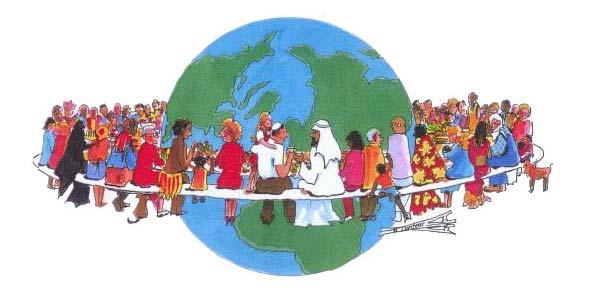Cultures around the world
"The crucial differences which distinguish human societies and human beings are not biological. They are cultural."
Cultures around the world are incredibly diverse and rich, shaped by a combination of historical, social, economic, and environmental factors. It's important to note that discussing every culture in detail would be impossible due to the vast number of cultures that exist. However, I can provide a brief overview of some prominent cultures from different regions of the world:
Western Culture: Western culture is often associated with Europe and North America. It has its roots in ancient Greece and Rome and has been influenced by Christianity, the Renaissance, Enlightenment, and industrialization. Western culture emphasizes individualism, democracy, scientific inquiry, and human rights.
Eastern Culture: Eastern cultures, including East Asian, South Asian, and Southeast Asian cultures, have their own distinct traditions. These cultures are often influenced by Confucianism, Buddhism, Hinduism, and other philosophical and religious systems. Eastern cultures place a strong emphasis on family, respect for elders, collectivism, and harmony with nature.
African Culture: Africa is home to a vast array of cultures due to its diverse ethnic groups. Each region and ethnic group in Africa has its unique traditions, languages, music, art, and cuisines. African cultures are known for their vibrant dances, oral storytelling traditions, intricate craftsmanship, and diverse spiritual beliefs.
Middle Eastern Culture: Middle Eastern cultures are primarily influenced by Islam, which plays a central role in shaping social, political, and religious practices. Middle Eastern cultures are known for their hospitality, traditional values, cuisine, calligraphy, and architecture, particularly exemplified by the mosques and palaces found in the region.
Latin American Culture: Latin American culture is a fusion of indigenous, European (mainly Spanish and Portuguese), and African influences. Each country in Latin America has its unique cultural traditions, including music (such as salsa, samba, and tango), dance, food (like tacos, empanadas, and ceviche), literature, and festivals (such as Carnival).
Indigenous Cultures: Indigenous cultures exist throughout the world and encompass a wide range of traditions and beliefs. These cultures often have a deep connection to the land, a strong oral tradition, and unique forms of art, music, and spirituality. Examples include the Native American cultures in North America, Aboriginal cultures in Australia, and Maori culture in New Zealand.
Oceanic Culture: The cultures of the Pacific Islands, including Polynesia, Melanesia, and Micronesia, are collectively referred to as Oceanic cultures. These cultures are known for their seafaring traditions, navigational skills, vibrant dances (such as hula and fire dancing), tattoo artistry, and unique customs and rituals.
Remember that these descriptions only scratch the surface of the immense cultural diversity that exists worldwide. Each culture is multifaceted and continually evolving, influenced by global trends and local dynamics. Exploring and appreciating different cultures can lead to a deeper understanding and appreciation of our shared humanity.
Διάβασε περισσότερα
Cultures around the world
"The crucial differences which distinguish human societies and human beings are not biological. They are cultural."
Cultures around the world are incredibly diverse and rich, shaped by a combination of historical, social, economic, and environmental factors. It's important to note that discussing every culture in detail would be impossible due to the vast number of cultures that exist. However, I can provide a brief overview of some prominent cultures from different regions of the world:
Western Culture: Western culture is often associated with Europe and North America. It has its roots in ancient Greece and Rome and has been influenced by Christianity, the Renaissance, Enlightenment, and industrialization. Western culture emphasizes individualism, democracy, scientific inquiry, and human rights.
Eastern Culture: Eastern cultures, including East Asian, South Asian, and Southeast Asian cultures, have their own distinct traditions. These cultures are often influenced by Confucianism, Buddhism, Hinduism, and other philosophical and religious systems. Eastern cultures place a strong emphasis on family, respect for elders, collectivism, and harmony with nature.
African Culture: Africa is home to a vast array of cultures due to its diverse ethnic groups. Each region and ethnic group in Africa has its unique traditions, languages, music, art, and cuisines. African cultures are known for their vibrant dances, oral storytelling traditions, intricate craftsmanship, and diverse spiritual beliefs.
Middle Eastern Culture: Middle Eastern cultures are primarily influenced by Islam, which plays a central role in shaping social, political, and religious practices. Middle Eastern cultures are known for their hospitality, traditional values, cuisine, calligraphy, and architecture, particularly exemplified by the mosques and palaces found in the region.
Latin American Culture: Latin American culture is a fusion of indigenous, European (mainly Spanish and Portuguese), and African influences. Each country in Latin America has its unique cultural traditions, including music (such as salsa, samba, and tango), dance, food (like tacos, empanadas, and ceviche), literature, and festivals (such as Carnival).
Indigenous Cultures: Indigenous cultures exist throughout the world and encompass a wide range of traditions and beliefs. These cultures often have a deep connection to the land, a strong oral tradition, and unique forms of art, music, and spirituality. Examples include the Native American cultures in North America, Aboriginal cultures in Australia, and Maori culture in New Zealand.
Oceanic Culture: The cultures of the Pacific Islands, including Polynesia, Melanesia, and Micronesia, are collectively referred to as Oceanic cultures. These cultures are known for their seafaring traditions, navigational skills, vibrant dances (such as hula and fire dancing), tattoo artistry, and unique customs and rituals.
Remember that these descriptions only scratch the surface of the immense cultural diversity that exists worldwide. Each culture is multifaceted and continually evolving, influenced by global trends and local dynamics. Exploring and appreciating different cultures can lead to a deeper understanding and appreciation of our shared humanity.





/radha-soami-marriage/images/Hindu_matrimony-f8972.jpg)


